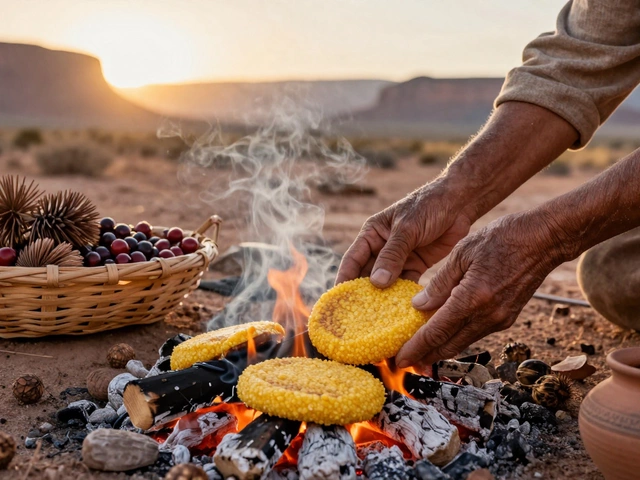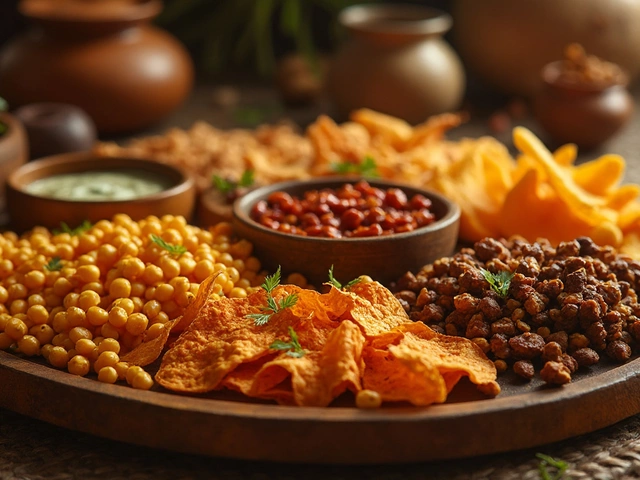Getting a dosa just right isn’t just about the batter. It’s about the oil. One wrong choice, and your dosa turns out soggy, greasy, or stuck to the pan. You’ve mixed your rice and urad dal perfectly, fermented it for 8 hours, and still - no crisp edges, no golden brown lacy texture. The problem? The oil you’re using.
Why Oil Matters More Than You Think
Most people think oil is just a lubricant for the pan. But in dosa-making, it’s part of the cooking chemistry. The right oil heats evenly, spreads thin, and crisps the batter without burning. The wrong one? It smokes, it soaks in, or it leaves a weird aftertaste. You don’t want your dosa tasting like burnt coconut or tasting like vegetable oil you bought in bulk at the supermarket.
Indian home cooks have been using the same oils for generations - and there’s a reason. Each oil has a different smoke point, flavor profile, and how it interacts with fermented batter. You need something that can handle high heat, doesn’t overpower the subtle tang of the batter, and helps create that signature crispness.
Top 5 Oils for Dosa - Ranked
Here’s what actually works, based on decades of kitchen testing and feedback from South Indian households, street vendors, and home cooks who make dosas daily.
- Coconut oil - The classic. Used in Kerala, Karnataka, and Tamil Nadu homes. It gives dosas a faint sweetness and a rich, nutty aroma. It has a medium smoke point (around 175°C), so you need to heat the pan just right - not too hot, or it’ll smoke. Best for traditional, soft-edged dosas with a hint of coconut flavor.
- Groundnut (peanut) oil - The most popular choice in restaurants and busy households. High smoke point (230°C), neutral taste, and spreads like butter on a hot griddle. It crisps the edges fast without burning. If you want that restaurant-style dosa with crisp, lacy edges, this is your go-to.
- Sunflower oil - A clean, light option. Smoke point around 230°C. It doesn’t add flavor, which is good if you want the batter to shine. Works well for people avoiding strong aromas. But it can sometimes make dosas a little too brittle if you use too much.
- Mustard oil - Strong flavor. Used in some parts of Bengal and Odisha. Not common for dosas, but if you like a pungent kick, it adds depth. Smoke point is moderate (210°C). Use sparingly - one teaspoon per dosa is enough. Not for beginners.
- Sesame oil - Only use toasted sesame oil for flavoring, not for frying. Raw sesame oil has a low smoke point and burns easily. A few drops drizzled at the end? Delicious. As the main oil? No. It’ll turn your dosa bitter.
What About Olive Oil or Avocado Oil?
Maybe you’re trying to eat healthier. Maybe you’ve heard olive oil is good for you. But here’s the truth: extra virgin olive oil has a smoke point around 160°C. That’s lower than coconut oil. When you pour it on a hot tawa, it smokes, turns bitter, and sticks. You’ll end up with a dosa that tastes like burnt grass.
Avocado oil? High smoke point (270°C) - great in theory. But it’s expensive, flavorless, and doesn’t help with crispness the way groundnut or coconut oil does. You’re paying more for no real gain. Stick to traditional oils. They’ve been tested for centuries.

How Much Oil Should You Use?
Less is more. A single teaspoon per dosa is enough. Use a paper towel or a silicone brush to spread it thinly across the pan. Too much oil, and your dosa becomes a greasy mess. Too little, and it sticks. The goal is a glistening surface, not a puddle.
Pro tip: Heat the tawa first. Then add the oil. Let it heat for 10 seconds. Pour the batter. The oil should shimmer, not smoke. If it smokes, your pan is too hot - turn down the heat.
Coconut Oil vs Groundnut Oil: The Ultimate Showdown
Let’s break it down. These two are the main contenders.
| Feature | Coconut Oil | Groundnut Oil |
|---|---|---|
| Smoke Point | 175°C | 230°C |
| Flavor | Subtle sweetness, nutty | Neutral |
| Crispness | Moderate | Excellent |
| Best For | Traditional, home-style dosas | Restaurant-style, crispy dosas |
| Health Factor | High in saturated fat | High in monounsaturated fat |
If you’re making dosas for kids or want that authentic Kerala taste, go with coconut oil. If you’re feeding a crowd and want them to crunch through the edges, groundnut oil wins. Many families keep both - coconut oil for weekend breakfasts, groundnut for weekday rush.
Common Mistakes to Avoid
- Using butter or ghee as the main oil - it burns too fast and makes dosas greasy.
- Reusing oil multiple times - old oil turns rancid and makes dosas taste stale.
- Adding oil after pouring the batter - always preheat the pan with oil.
- Using cold oil - it soaks into the batter and makes it soggy. Always use room temperature oil.
- Choosing cheap refined oils with additives - they can alter the flavor and leave a chemical aftertaste.

What Do South Indian Chefs Use?
Walk into any dosa stall in Chennai, Bangalore, or Coimbatore, and you’ll see one thing: a large metal pot of groundnut oil. Why? Because it’s affordable, reliable, and consistent. Street vendors make hundreds of dosas a day. They can’t afford to mess up.
Home cooks in Kerala? They’ll tell you coconut oil is non-negotiable. Even the oil they use for frying banana chips is the same one they use for dosas. It’s part of their food culture.
The truth? There’s no single ‘best’ oil. It depends on what you’re going for - tradition, crispness, or flavor. But if you want to get it right every time, start with groundnut oil. It’s the most forgiving and the most widely used.
Storage Tips for Dosa Oil
Don’t leave oil sitting in the pan. Pour it back into a sealed glass bottle after cooling. Keep it in a cool, dark place. Groundnut oil lasts 6-8 months. Coconut oil lasts longer - up to a year if stored properly. If it smells off, toss it. No exceptions.
Pro tip: Label your bottles. If you keep both coconut and groundnut oil, mix them up and you’ll ruin a batch of dosas.
Final Verdict
For most people, groundnut oil is the best all-around choice. It’s affordable, high-performing, and doesn’t fight with the batter’s flavor. If you want that authentic, slightly sweet, aromatic dosa - go with coconut oil. But don’t expect it to crisp up like a street vendor’s.
Don’t overthink it. Use one oil. Stick with it. Master the heat. Spread it thin. That’s how you get the perfect dosa - not by chasing the ‘best’ oil, but by understanding how the one you choose behaves.
Can I use butter instead of oil for dosa?
No. Butter burns at low temperatures and makes dosas greasy and uneven. It also doesn’t spread well on a hot tawa. Stick to oils with high smoke points like groundnut or coconut oil.
Is coconut oil healthier than groundnut oil for dosa?
Coconut oil has more saturated fat, while groundnut oil has more heart-healthy monounsaturated fats. If you’re watching fat intake, groundnut oil is the better choice. But coconut oil has antimicrobial properties and adds flavor. Neither is ‘bad’ - it’s about your goals.
Why does my dosa stick even when I use oil?
Most likely, your tawa isn’t hot enough. The oil needs to shimmer before you pour the batter. Also, check your batter consistency - too thick or not fermented enough causes sticking. Use a well-seasoned cast iron or non-stick tawa.
Can I mix oils for dosa?
Yes. Some cooks mix 80% groundnut oil with 20% coconut oil to get both crispness and flavor. Just make sure both oils have similar smoke points. Don’t mix sesame or olive oil - they’ll ruin the batch.
What oil do South Indian restaurants use?
Over 90% use groundnut oil. It’s cheap, neutral, and gives consistent crispness. Coconut oil is used in homes in Kerala and parts of Karnataka, but restaurants prioritize speed, cost, and reliability - which is why groundnut oil dominates.











